Chapter 4. Wound Care
4.9 Drain Management and Removal
Drain Management
Drain systems are a common feature of post-operative surgical management and are used to remove drainage from a wound bed to prevent infection and the delay of wound healing. A drain may be superficial to the skin or deep in the tissue, duct, or cavity. The number of drains depends on the extent and type of surgery. Active drains are closed systems that use vacuum action to withdraw fluids from the site into a collection reservoir. The drainage tube is a silastic tube with perforations to allow fluid to be sucked away from the site. Closed systems should be emptied when they are 1/3 to 1/2 full to allow the drain to function optimally. At minimum they should be emptied and measured at least once every shift, and the ports cleaned according to agency policy. These drains are very common and are referred to as Hemovac or Jackson Pratt (Perry et al., 2018).
Hemovac drains (see Figure 4.5) can hold up to 500 ml of drainage. A Jackson Pratt (JP) (see Figure 4.6) is used for wounds anticipated to have smaller amounts of drainage. Drains are often sutured to the skin to prevent accidental removal. The drain insertion site is covered with a sterile dressing. Assessment of drain functioning periodically throughout the day is important. These types of drains are referred to as active drains because of the suction action used to remove drainage. They are also referred to as closed wound drains because the drain system is closed.
Passive drains, also known as capillary drains, work by providing an opening from the area of concern to the outside of the body. Gravity and body movement allow excess fluid to simply escape through the opening. Penrose drains are pieces of surgical tubing inserted into a surgical site, secured with a suture on the skin surface, and they drain into a sterile dressing (Perry et al., 2018). Care and maintenance includes frequent dressing changes and attention to the peri-wound skin, which is at risk for breakdown in the presence of ++ moisture. Removal of capillary drains requires attention to avoid losing the drain into the patient’s body when the securing suture is released.
Pigtail drains (see Figure 4.7) are another type of passive drain. They are a type of tubing inserted into the site, held in place by the tube’s curl at the end. These can also be sutured on the skin surface. Pigtail drains are attached to a drainage bag and are often used to manage the treatment of abscesses (RSNA, 2018).
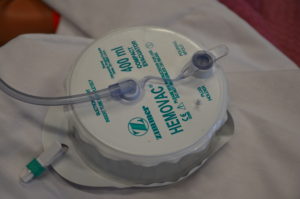
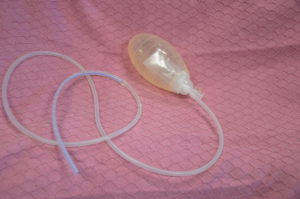
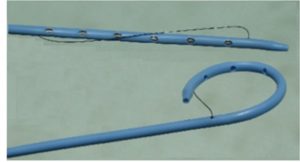
Checklist 40 outlines the steps to take when emptying a closed wound drainage system.
Checklist 40: Emptying a Closed Wound Drainage SystemDisclaimer: Always review and follow your agency policy regarding this specific skill. |
|
Safety considerations:
|
|
Steps |
Additional Information |
| 1. Perform hand hygiene. | Hand hygiene reduces the risk of infection
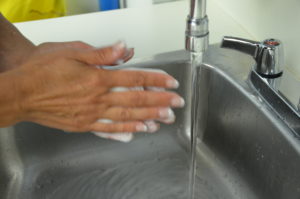 |
| 2. Collect necessary supplies. | For example: drainage measurement container, non-sterile gloves, waterproof pad, alcohol swab |
| 3. Apply non-sterile gloves and goggles or face shield according to agency protocols and/or point of care risk assessment. | PPE reduces the transmission of microorganisms and protects against accidental body fluid exposure.
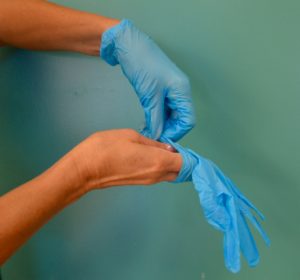 |
| 4. Maintaining principles of asepsis, remove plug from pouring spout as indicated on drain. | Open plug while pointing away from your face to avoid an accidental splash of body fluid.
Maintain asepsis in relation to the plug. The vacuum will be broken and the reservoir (drainage collection system) will expand. 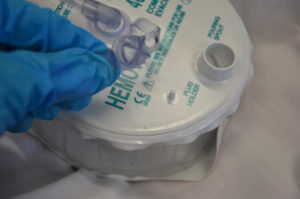 |
| 5. Gently tilt the opening of the reservoir toward the measuring container and pour out contents. Note character of drainage: colour, consistency, odour, and amount. | Pour away from yourself to prevent exposure to body fluids. Drainage counts as patient fluid output and must be documented on the patient chart as per hospital protocol.
Monitor drains frequently in the post operative period to reduce the weight of the reservoir and to monitor drainage. A recommendation is to empty when 1/3 to 1/2 full because they get heavy. |
| 6. Swab the surface of the pouring spout and plug with an alcohol swab. Place drainage container on bed or hard surface, tilt away from your face, and compress the drain to flatten it with one hand. |
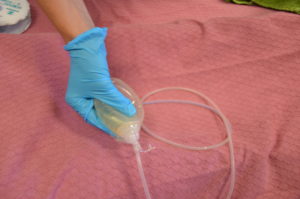 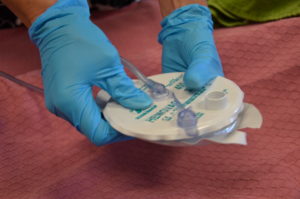 |
| 7. Place the plug back into the pour spout of the drainage system, maintaining asepsis. | This establishes vaccum suction for drainage system
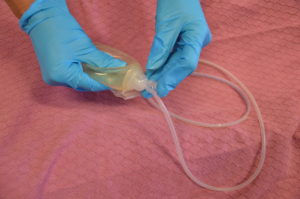  |
| 8. Secure device onto patient’s gown using a safety pin; ensure drain is functioning; ensure that enough slack is present on tubing. | Securing drain decreases risk of inadvertent removal. Providing enough slack to accommodate patient movement prevents tension at the drain insertion site. |
| 9. Discard drainage according to agency policy. | Protection of HCWs against exposure to BBF. |
| 10. Remove gloves and perform hand hygiene. | Hand hygiene must be performed after removing gloves. Gloves are not puncture-proof or leak-proof, and hands may become contaminated when gloves are removed.
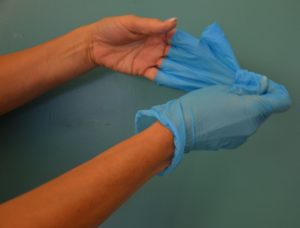 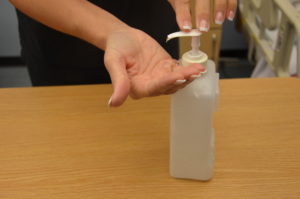 |
| 11. Document procedure and findings according to agency policy. Report any unusual findings or concerns to the appropriate healthcare professional. | This allows for accurate recording of drainage.
If more than one drain is present, number them, note their location in the chart. Chart each one separately. If the amount of drainage increases or changes, notify the appropriate healthcare provider according to agency policy. If the amount of drainage significantly decreases, the drain may be ready to be removed. |
|
Data sources: BCIT, 2010b; Perry et al., 2018 |
|
Removal of a drain must be ordered by the prescriber. A drain is usually in place for 24 to 48 hours, and removal depends on the amount of drainage over the previous 24 hours.
Drain Removal
Checklist 41 outlines the steps for removing a wound drainage system (hemovac and JP) ** this is not the guidelines for removal of pigtail drains. Refer to your agency policy.
Checklist 41: Drain RemovalDisclaimer: Always review and follow your agency policy regarding this specific skill. |
|
Safety considerations:
|
|
Steps |
Additional Information |
| 1. Confirm that the prescriber order correlates with the amount of drainage in the past 24 hours. | The prescriber should specify an amount for acceptable drainage for the drain to be removed. When in doubt, ask. |
| 2. Explain procedure to patient; offer analgesia and bathroom as required. | Taking this step decreases the patient’s anxiety about the procedure. Explain to the patient that a puling sensation may be felt but will stop after the procedure is complete.
Analgesia provides comfort and achieves the goal of an acceptable pain level for the procedure. |
| 3. Assemble supplies at patient’s bedside: dressing tray, sterile suture scissors or sterile blade, cleansing solution, tape, garbage bag, outer dressing. | Organizing supplies helps the procedure occur as efficiently as possible for the patient. |
| 4. Apply a waterproof drape or pad for setting the drain onto once it has been removed. | This provides a place to put the drain once it is removed. |
| 5. Perform hand hygiene. | Reduces risk of introducing microorganisms from elsewhere to the patient.
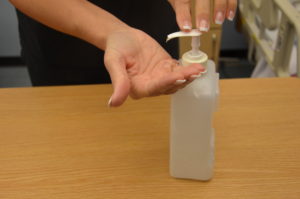 |
| 6. Apply non-sterile gloves and PPE according to Point of Care Risk Assessment. |
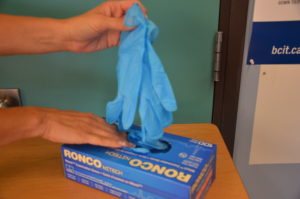 |
| 7. Release suction on reservoir and empty; measure and record volumes greater than 10 ml.
Remove dressing. |
 |
| 8. Clean and dry the incision and drain site following principles of asepsis. | Prepares the wound and surrounding tissue, may reduce microorganism counts. |
| 9. Carefully cut and remove the securing suture following principles of asepsis. | If you forget to cut the suture, the drain will be stuck. |
| 10. While holding two to three 4 × 4 sterile gauze in non-dominant hand, stabilize skin. | Sometimes additional drainage oozes out during drain removal. Sterile gauze provides a barrier to decrease risk of introducing microorganisms into the wound. Counter-pressure to the skin near the drain decreases discomfort to the patient.
Consider the use of sterile gloves if there is risk of introducing bacteria into the wound during drain removal. |
| 11. Ask patient to take a deep breath and exhale slowly; remove the drain as the patient exhales.
Firmly grasp the drainage tube close to the skin with dominant hand, and with a swift and steady motion withdraw the drain. |
Distraction helps the patient prepare for drain removal. Slight resistance may be felt. If there is strong resistance, hold your pull and ask the patient to take a deep breath. Sometimes the muscles need a little encouragement to relax. If you still can’t remove it, stop and call the prescriber.
Gather up the drain tubing in your hand as it is being removed. When removed, ensure the drain tubing and the tip are intact. |
| 12. Place drain and tubing onto waterproof pad or into garbage bag. Remove gloves. | Prevents the drain and tubing from contaminating the bed or floor. |
| 13. At this point some nurses will clean and dry the wound. | The nurse can decide depending on the situation. |
| 14. Dress the wound with sterile dressing. | Drain sites often drain for a few days after. Consider adding some gauze under the cover dressing for extra absorbency.
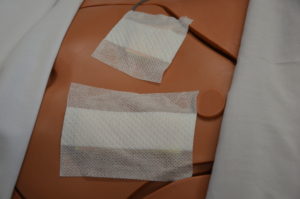 |
| 15. Discard drain and garbage as per agency policy. | Decreases risk of BBF exposure to others. |
| 16. Perform hand hygiene |
 |
| 17. Assess dressing 30 minutes after drain removal. Likewise, ask the patient to call if they notice any increased drainage from the site. | Monitor for excessive drainage from the drain site. |
| 18. Document procedure (including drain removal, drain output and characteristics, how the patient tolerated the procedure, dressings applied) or according to agency policy. Report any unusual findings or concerns to the appropriate healthcare professional. | Accurate and timely documentation and reporting promotes patient safety.
Sample charting: date / time: JP drain to RLQ site cleansed with NS. 5 ml sanguinous drainage in past 24 hours. Securing suture removed. Drain removed. Tip intact. Site free of complications. Site dressed with 4- 2×2 guaze and Medipore™. Patient tolerated well.——————————–R.Barns RN |
| Data sources: BCIT, 2010b; Interior Health, n.d.; Perry et al., 2018; Saskatoon Health Region, 2012 | |
Watch the video JP Drain Removal developed by Renée Anderson & Wendy McKenzie Thompson Rivers University School of Nursing (2014).
Critical Thinking Exercises
- When you start to remove your patient’s Jackson Pratt drain, you notice there is 100 ml of fresh blood in the drainage bulb. What would be your next steps?
- Describe ways in which you can help relieve the discomfort felt by a patient while removing a wound drain.
Attributions
Figure 4.7 Pigtail drain by Agency for Clinical Innovation is used under a CC BY 4.0 license.

